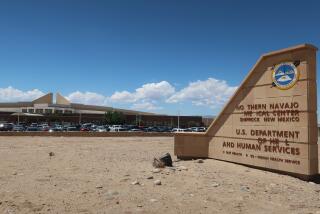Major Flaw in Efforts to Reform Health Care: No Room for ‘Crackpots’
Not even 20 years ago, the few doctors and nutritionists who championed diet for cancer prevention were viewed as medicine’s lunatic fringe. Today, the National Cancer Institute publishes beautiful four-color wall posters festooned with leafy vegetables that remind you to eat your beta carotene.
“We used to call them crackpots,” acknowledges Robert Blendon, chairman of Health Policy and Management at Harvard’s School of Public Health. “Now we have our best epidemiologists running the numbers on their studies.”
The nation spends more than $12 billion a year on bypass procedures--almost 40% more than the entire budget for the National Institutes of Health. Since 1970, the number of bypasses performed in America has grown by more than 2,800%. In addition, about 300,000 arterially choked Americans now get themselves unplugged through angioplasties costing up to $10,000 each. These cardiovascular surgeries are the biggest-ticket surgical items in the nation’s $800-billion-plus annual health care budget.
Yet there are a number of respected and statistically compelling studies demonstrating that--for a large percentage of the patients undergoing these invasive procedures--the health benefits are marginal at best.
For most angioplasty patients, for example, the arteries begin to exhibit “restenosis”--choking up with fatty deposits yet again--within months. Within the cardiovascular establishment, there are angry debates not merely about the cost-effectiveness of bypasses and angioplasties but about their usefulness.
“Science is not applied nearly as uniformly and consistently as people might believe in the evaluation of treatment modalities,” says Dr. Dean Ornish, president and director of the San Francisco-based Preventive Medicine Research Institute, who has enjoyed excellent results exploring lifestyle--as opposed to surgical--interventions for reversing heart disease. “Whether you’re on the leading edge or the fringe is merely a matter of perspective or time--so long as you can successfully demonstrate results.”
Consequently, much of today’s health care debate about who should pay how much for what kind of coverage misses the essential point. Health care “cost-effectiveness” conversations that spend 90% of the time focusing on “cost” and barely 10% on the challenge of “effectiveness” obscure rather than clarify the issues that deserve intensive care.
To make 37 million people eligible for medical procedures that don’t really work can hardly be considered a bold advance in public health.
The simple reality is that medicine remains more of a craft than a science. Perhaps the most important contribution of the proposed Clinton health policy initiative is that it will--gradually--force society and health care providers to come to grips with our ignorance of what medically works and what doesn’t.
Ideally, this knowledge would lead us to a consensus about what treatments and therapies are appropriate for what populations. In practice, we may well see a further Balkanization of health care as different pharmaceutical houses, hospital plans and specialists develop dueling databases to argue that their approaches are the best.
“In too many areas, we actually don’t know the outcomes of treatments and interventions,” says Harvard’s Blendon. “There was belief in clinical judgment in how well things worked out or not, but the statistics revolution made people suspicious of the judgments of six or eight doctors who saw 20 patients. It turns out that if you really had extensive epidemiological data, much clinical judgment turns out to be fallacious.”
Indeed, Blendon and other health care researchers believe that excellence in medical practice is moving away from the collective judgments of expert practitioners to broad-ranging, extensive database analyses of health “outcomes” based on treatments and populations. So whose studies will “win”? How will outcomes research be linked to the actual practice of medicine? The answer to these questions--not just who gets covered for how much--will really determine the future value of America’s health care system.
“Outcomes research is a relatively new type of health care research,” says Clifton Gaus, senior adviser to the assistant secretary for health at the Department of Health and Human Services. “We now spend about $60 million a year on outcomes research and the development of guidelines for practitioners.”
Gaus notes that the Clinton plan will require a big increase in both the quality and quantity of outcomes research if it hopes to attain its stated goal of greater cost-effectiveness and efficiencies.
“I’m extraordinarily comfortable with the notion that we must develop immediately mechanisms, rule guidelines and eliminate unnecessary procedures,” says Dr. Robert H. Brook, who runs RAND’s Health Sciences Program and has done extensive work on outcomes analysis and guideline development.
But even he acknowledges that RAND surveys reveal that as many as half the nation’s physicians are unaware of essential “best practices” in many critical health care diagnoses and treatments. Clearly, new information isn’t enough to change old practices.
HHS’ Gaus points out that the new National Health Board will be charged with transforming outcomes research into explicit guidelines for how the regional alliances run their health care practices. But he acknowledges that it’s still unclear precisely how that sort of transformation will take place.
It’s unfortunate that neither the President nor the First Lady has placed the same kind of focus on the quality and value of health care as they have on access and cost. As the policy debate unfolds, politicians will discover that Americans care more about outcomes than they do about expense.






